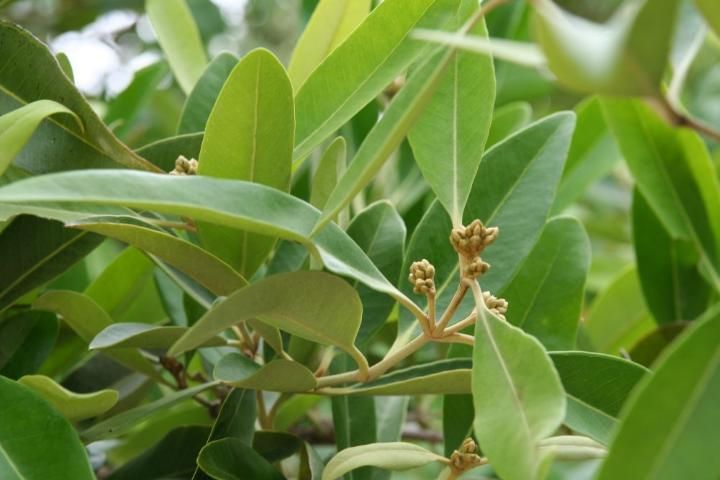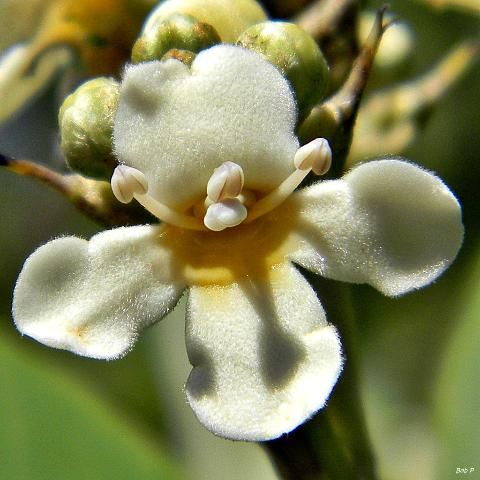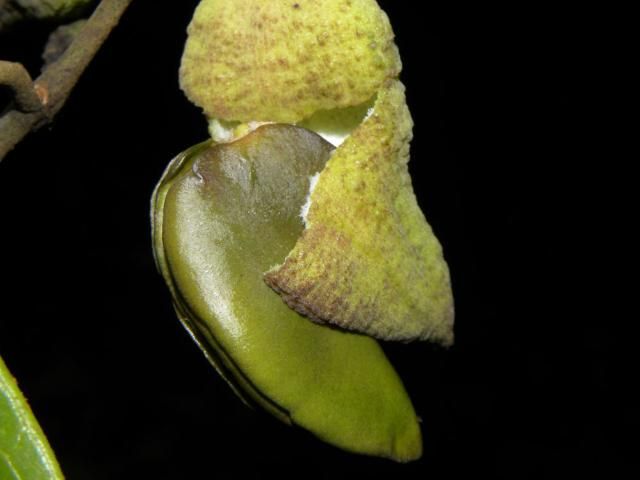Family
Acanthaceae, bear's breeches family.
Genus
Avicennia was named for an Iranian philosopher and physician who lived from 980 to 1037 A.D. His alias was Avicenna but his real name was Abu Ali Al-Husayn Ibn 'Abd Allah Ibn Sina.
Species
The species name, germinans, is the Latin term for germination.
Common Name
Black Mangrove
The origins of the term "mangrove" are disputed among both scholars and laypersons. Some assign the origin to the Malaysian term for the trees: mangi-mangi. Others believe that it originates from the Spanish term mangle or "thicket," first used by Gonzalo Fernández de Oviedo y Valdés in 1535 A.D. to describe the tangled thicket of branches and roots mangroves form as they grow along shorelines.
Description
The black mangrove is a coastal evergreen tree native to Florida. It is found on mudflats and coasts throughout tropical and sub-tropical regions in the Americas. In the mangrove forests of Florida, it generally grows between red mangroves (Rhizophora mangle), which are found in standing waters, and white mangroves (Laguncularia racemosa), which are more of an upland species. Black mangroves grow best in full sun and can reach heights of 40 to 50 feet. Leaves are simple and opposite and grow from 2 to 3 inches long. The leaf is oval and pointed, and the margins are entire. The leaves appear smooth, thick, and leathery with a dark green topside and grey to white underside. The topside of the leaves may also appear white due to the formation of crystals from salt that is excreted from the leaves. The bark of black mangrove is dark gray or brown. When the tree is young the bark is smooth and as it matures the bark takes on a thick and fissured texture. The roots produce vertical "branches" called pneumatophores, which rise from the ground and grow to a height that is just above high tide. This helps the tree "breathe" during water inundation. The flowers appear at the ends of the branches and are small, white, and fragrant with yellow centers. Fruits appear throughout the year and consist of large flattened capsules of seeds shaped like lima beans, which germinate while still on the tree.

Credit: Wildlife Travel, CC BY-NC-ND 2.0

Credit: bob in swamp, CC BY-SA 2.0

Credit: Reinaldo Aguilar, CC BY-NC-SA 2.0
Storm Tolerance
This coastal tree is tolerant of waterlogged conditions and of salt in both the air and soil. Black mangroves, like other species of mangroves, are able to withstand major storm events like hurricanes. This allows them to inhabit large expanses of the storm prone coastline of Florida, where they stabilize sediments and protect the shoreline from erosion.
Applications
Commercial/Practical
Though the wood of black mangrove is hard, it cracks easily. However, it has been used in a variety of ways, mainly as posts and flooring. In the past, it was an important source of fuel as charcoal. The bark of the black mangrove has been used in the process of tanning animal skins and as a black dye. The leaves, which excrete salt crystals, have been gathered as a source of salt by indigenous people. Black mangrove flowers are also an important source of "mangrove honey."
Horticultural
As a landscape plant, black mangroves have been planted along brackish river banks or even in upland areas. It makes a nice shade tree or a screening tree due to its thick foliage.
Medicinal
The tannins in black mangrove have been used as an astringent, carrying antihemorhagic and antidiarrhetic properties.
Wildlife
Organisms on the bottom of the aquatic food chain that live along the shoreline benefit from the food and shelter provided by the black mangrove. The tangled mass of roots and branches serves as a nursery ground for many organisms. The fish and crabs that inhabit mangroves are not only important to the structure of mangrove ecosystems, but are important for local fisheries. Despite laws that have been passed to protect mangroves, large areas have been cut down to make room for human development.
References
Austin, D. F. 2004. Florida ethnobotany. Boca Raton, FL: CRC Press.
Duke, J. A. 1983. Handbook of Energy Crops. Retrieved from https://hort.purdue.edu/newcrop/duke_energy/Avicennia_germinans.html
Godfrey, R. K. 1988. Trees, shrubs, and woody vines of Northern Florida and adjacent Georgia and Alabama. Athens, GA: The University of Georgia Press.
Grimm, W. C. 2002. The illustrated book of trees. Mechanicsburg, PA: Stackpole Books.
Haehle, R. J. and J. Brookwell. 2004. Native Florida plants: Low-maintenance landscaping and gardening. Lanham, MD: Taylor Trade Publishing.
Myers, R. L. and J. J. Ewel, Eds. 1990. Ecosystems of Florida. Orlando, FL: The University of Central Florida Press.
Nelson, G. 1994. The trees of Florida: A reference and field guide. Sarasota, FL: Pineapple Press.